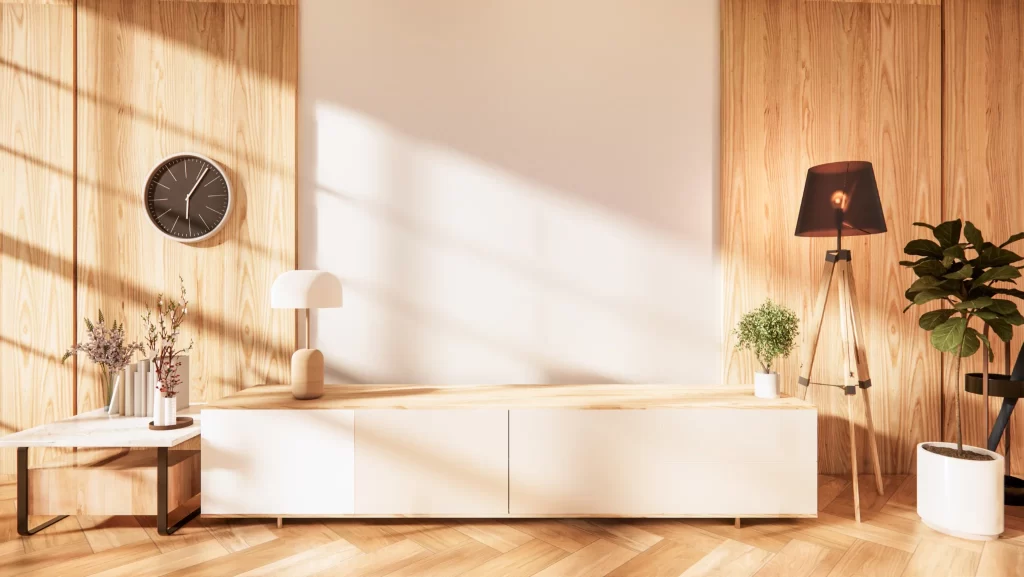The 1970’s, known for disco, bell-bottoms, and bold expressions, also left a lasting impression on interior design. One iconic element that defined the aesthetics of the 70’s and continues to evoke nostalgia is wood paneling. In this article, we explore the principles behind 70’s wood paneling decor, unveiling its resurgence in contemporary design.
Nostalgia and Revival
Nostalgia plays a significant role in the resurgence of 70’s wood paneling. People seeking to capture the comforting and familiar atmosphere of the past revisit the 70’s style while simultaneously infusing it with a modern twist. This revival is more than a mere trend; it’s a deliberate choice to blend the old with the new.

Distinct Characteristics of 70’s Wood Paneling
Hues and Tones
The color palette of the 70s is a rich tapestry of warmth, characterized by earthy tones that defined the era’s interior design. Deep browns, olive greens, and mustard yellows were prevalent, creating a cozy and inviting ambiance in spaces adorned with wood paneling. These warm hues not only reflected the design sensibilities of the time but also contributed significantly to the overall feel of a room.
Textures and Patterns
Delving into the intricate textures and geometric patterns that characterized 70s wood paneling decor reveals a design heritage that goes beyond a mere aesthetic choice. The textures, often tactile and rich, were integral to the sensory experience of a space.
Utilizing Wood Paneling in Modern Design
Accent Walls
One of the timeless applications of wood paneling is creating accent walls. Whether it’s in the living room or bedroom, a well-designed wood-paneled accent wall adds a touch of retro charm while remaining a versatile backdrop for various decor styles.

Contemporary Furniture Pairing
Embracing 70’s wood paneling doesn’t require an all-encompassing commitment. Integrating wooden furniture or accessories, such as coffee tables or wall art, gives a subtle homage to the era without overshadowing contemporary elements.
Striking a Balance
Rather than overwhelming a space, designers and homeowners are now opting for strategic placement that evokes the charm of the past without over saturating the present. Focusing on a singular accent wall or selectively incorporating wood-paneled furniture pieces allows for a nuanced infusion of the vintage vibe. This deliberate choice not only prevents spaces from slipping into a time capsule but also ensures a harmonious blend with modern elements. The contemporary design ethos, in embracing the 70’s aesthetic, emphasizes the importance of restraint, turning each application of wood paneling into a deliberate design decision. It’s about curating an experience that pays homage to the past while staying relevant in the current design trends.
Lighting Considerations
The resurgence of 70’s warmth through wood finds its full glory when bathed in the right light. Balancing natural and artificial lighting is a meticulous consideration to prevent spaces from feeling dim or overly shadowed.
Well-lit areas not only showcase the intricate details and character of the wood but also contribute to the overall aesthetics of a room. The interplay of light and shadow on wood paneling can accentuate its warmth, creating a dynamic visual experience. Designers carefully curate lighting schemes that complement the richness of the wood, ensuring that each space feels inviting and elegantly illuminated.

Environmental Considerations
As sustainability gains prominence, considering the environmental impact of using wood paneling is crucial. Opting for reclaimed or responsibly sourced wood aligns with contemporary values of eco-conscious living.
Contemporary Popularity and Breaking Stereotypes
The resurgence of 70’s wood paneling in contemporary design showcases its versatility. From rustic farmhouses to urban lofts, designers leverage its warmth and character to create inviting and visually striking interiors.
Cultural Impact of 70’s Wood Paneling
The cultural impact of 70’s wood paneling is akin to a visual narrative, telling the story of an era marked by a distinctive embrace of self-expression and individuality. Beyond its purely aesthetic role, wood paneling from the 70s signifies a departure from the prevailing design norms of previous decades. This departure wasn’t just a shift in style; it was a statement, a rebellion against the rigid confines of traditional design.
In the 1970s, interior spaces became canvases for personal expression. Homeowners sought to break free from the monotony of uniform walls, and wood paneling emerged as a symbol of this rebellion. It wasn’t merely a design choice; it was a cultural movement that celebrated diversity, creativity, and a willingness to challenge established norms.

In conclusion, the resurgence of 70’s wood paneling is not merely a trend but a deliberate choice to bridge the past and the present. By understanding its principles and creatively incorporating them into contemporary design, homeowners and designers alike can create spaces that are both nostalgic and forward-thinking.
FAQs
Is wood paneling suitable for modern homes?
Absolutely. When used strategically, wood paneling adds a timeless and warm touch to modern interiors.
Are there eco-friendly options for wood paneling?
Yes, opting for reclaimed or sustainably sourced wood is an environmentally conscious choice.
Does wood paneling work in small spaces?
Yes, but it’s essential to use it selectively to avoid overwhelming smaller rooms.
What other materials complement wood paneling?
Materials like glass, metal, and concrete can create a balanced and modern aesthetic alongside wood paneling.








